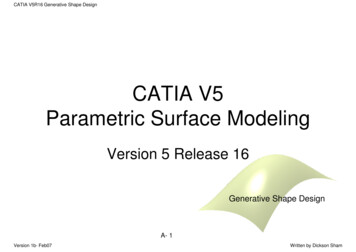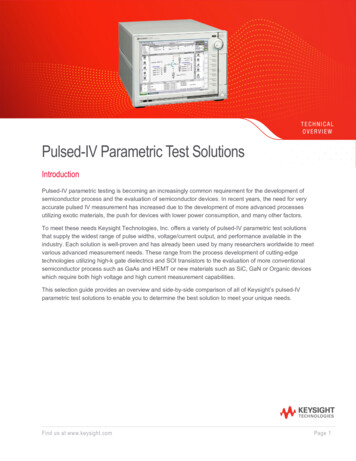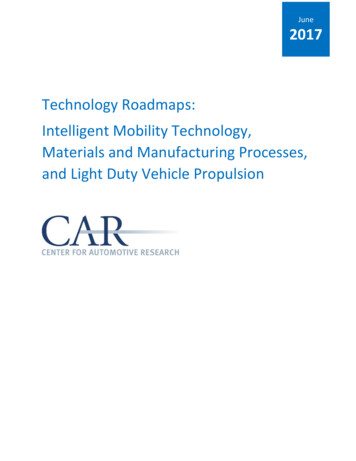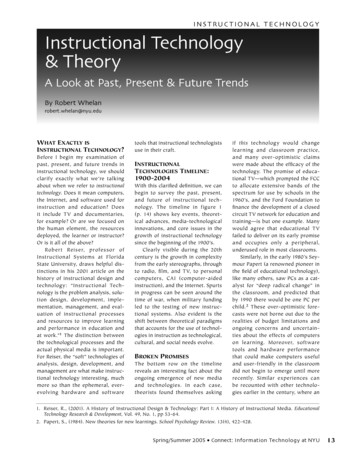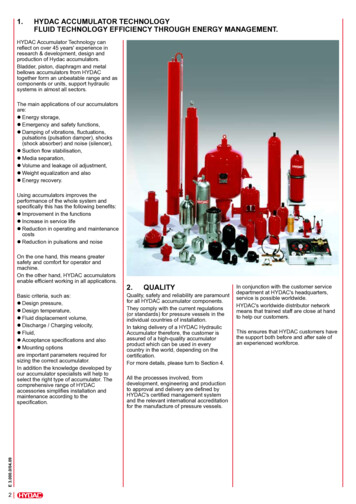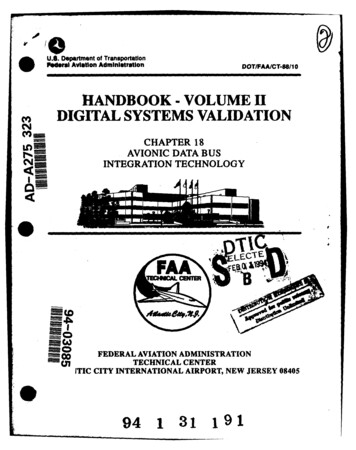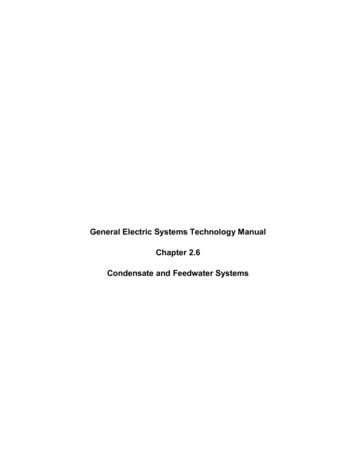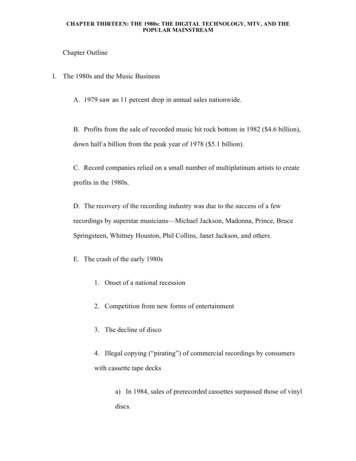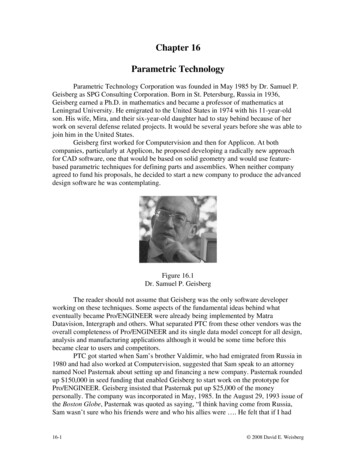
Transcription
Chapter 16Parametric TechnologyParametric Technology Corporation was founded in May 1985 by Dr. Samuel P.Geisberg as SPG Consulting Corporation. Born in St. Petersburg, Russia in 1936,Geisberg earned a Ph.D. in mathematics and became a professor of mathematics atLeningrad University. He emigrated to the United States in 1974 with his 11-year-oldson. His wife, Mira, and their six-year-old daughter had to stay behind because of herwork on several defense related projects. It would be several years before she was able tojoin him in the United States.Geisberg first worked for Computervision and then for Applicon. At bothcompanies, particularly at Applicon, he proposed developing a radically new approachfor CAD software, one that would be based on solid geometry and would use featurebased parametric techniques for defining parts and assemblies. When neither companyagreed to fund his proposals, he decided to start a new company to produce the advanceddesign software he was contemplating.Figure 16.1Dr. Samuel P. GeisbergThe reader should not assume that Geisberg was the only software developerworking on these techniques. Some aspects of the fundamental ideas behind whateventually became Pro/ENGINEER were already being implemented by MatraDatavision, Intergraph and others. What separated PTC from these other vendors was theoverall completeness of Pro/ENGINEER and its single data model concept for all design,analysis and manufacturing applications although it would be some time before thisbecame clear to users and competitors.PTC got started when Sam’s brother Valdimir, who had emigrated from Russia in1980 and had also worked at Computervision, suggested that Sam speak to an attorneynamed Noel Pasternak about setting up and financing a new company. Pasternak roundedup 150,000 in seed funding that enabled Geisberg to start work on the prototype forPro/ENGINEER. Geisberg insisted that Pasternak put up 25,000 of the moneypersonally. The company was incorporated in May, 1985. In the August 29, 1993 issue ofthe Boston Globe, Pasternak was quoted as saying, “I think having come from Russia,Sam wasn’t sure who his friends were and who his allies were . He felt that if I had16-1 2008 David E. Weisberg
some money up, I would fight even harder for him.” 1 More than 20 years later, Pasternakis the company’s non-executive chairman of the board.In all, about 750,000 in initial seed funding was raised from Adage, CharlesRiver Ventures and others. The key step was building an organization that couldcomplete the development of Geisberg’s software ideas and bring the resulting product tomarket. The bulk of the early development work was done by Geisberg and four or fiveassociates. Mike Payne, who had spent a number of years at Prime Computer as directorof CAD/CAM research and development, joined PTC in March 1986 and a month laterbecame vice president of development.Being basically a mathematician and software developer, Geisberg and hisbackers recognized fairly quickly that they needed someone with more managementexperience to run the company on a day-to-day basis and as a consequence the companyhired Steven C. Walske as president and chief executive officer in December 1986.Walske received an MBA from Harvard Business School in 1978 and was CFO ofComputer Corporation of America prior to joining PTC. Under his leadership thecompany grew from a cold start to over 1 billion in revenue 12 years later.After Walske joined the company, Geisberg became executive vice president ofresearch and development. Six months later, Dick Harrison was hired as vice president ofsales and the company’s name was changed to Parametric Technology Corporation.Harrison had previously been a sales executive with Celerity Computing and PrimeComputer.In mid-1987 the company raised an additional 3.6 million in venture capitalfunding from Charles River Ventures 2 and others and began to prepare Pro/ENGINEERfor launch later that year. About the same time, the company began demonstrating anearly version of the software to the press. Publications including CAD/CIM Alert and TheAnderson Report were suitably impressed. While most CAD software vendors had apreferred computer platform on which the company developed software and then portedthe software to other platforms, PTC took the approach of developing its software onmultiple platforms at the same time. Initially, this included workstations from Sun, DEC,Apollo, SGI and NEC. Except for using VMS on the DEC systems, PTC focused onUNIX as its primary operating system. While there was talk of a version that would runon an IBM System/2 PC or an Apple Macintosh, the PC version would have to wait forMicrosoft’s release of Windows NT in 1993.According to Geisberg at the time:"The goal is to create a system that would be flexible enough toencourage the engineer to easily consider a variety of designs. And thecost of making design changes ought to be as close to zero as possible. Inaddition, the traditional CAD/CAM software of the time unrealisticallyrestricted low-cost changes to only the very front end of the designengineering process." 31Boston Globe, August 29, 1993One of the general partners at Charles River Ventures was Don Feddersen, a former president and CEO ofApplicon who was a director at PTC for a number of years.3Teresko, John, Industry Week, December 20, 1993216-2 2008 David E. Weisberg
Prior to Pro/ENGINEER’s formal release, the expected base price for the softwarewas 12,500. The entire suite consisted of about ten different modules including basicsketching, feature-based modeling, drawing generation, assembly modeling, surfacegeometry, data management, etc. Eventually these modules, along with many othercapabilities, would become part of the basic Pro/ENGINEER product. Although allmodeling was done with solid geometry, users could work with either wireframe orhidden-line images as well as shaded images. Most early users worked predominatelywith wireframe images due to the performance of contemporary workstations. 4Beta testing of Pro/ENGINEER began in September 1987 with the first publicdemonstrations taking place at AUTOFACT in Detroit, Michigan in November 1987.Commercial shipments began in January 1988. The price for the basic software whichconsisted of parametric geometry creation, drawing generation, assembly modeling, andIGES 3.0 was reduced to 9,500. The company’s initial distribution plan was to usedealers (Value Added Resellers or VARs) and OEM resellers. At product introduction,PTC had lined up four domestic dealers and two in Japan. The plan was to have 50dealers by the end of 1988. It was not long before the company incurred significantconflict between these outside firms and its internal direct sales force.Functional Description of Pro/ENGINEERAlthough individual aspects of Pro/ENGINEER had appeared earlierin competitive software products, this product’s introduction in late 1987was the first time these capabilities had been grouped together in a singlesoftware suite together with a fairly straightforward user interface. Twobasic principals drove the early development of Pro/ENGINEER. One wasthe use of parametric, feature-based solids modeling while the other wasthe concept that all applications in this software suite would use a commondata structure.While competitive products such as Computervision’s CADDS 4X andMcAuto’s Unigraphics II were fundamentally wireframe based with solidsadded as an extra capability, Pro/ENGINEER was implemented from thestart as a solids-based system. Everything was done with double-precisionsolid geometry and NURBS surfaces.To create a model, the user typically started by creating a profile of theobject. This shape was then converted into a solid model by translating itthrough space or revolving it around a centerline. Additional geometrycould be added or subtracted from the base model. Some of the geometrywas in the form of features such as holes, bosses, ribs, etc.A key characteristic of Pro/ENGINEER was that as the model wascreated, the software recorded each step the operator took. This wasreferred to as a “history tree.” The software also recoded geometricaspects of the model such as whether two surfaces were parallel or the factthat a hole was a specified distance from the edge of the part. Eachdimension used to define the part was also recorded. If the user placed athrough hole in a block and the thickness of the block was later increased,4CAD/CIM Alert, July 1987, Pg. 11 and The Anderson Report, July 1987, Pg. 316-3 2008 David E. Weisberg
the length of the hole would increase proportionately. With older solidmodelers, the user would have been left with the hole ending inside theblock.One aspect of Pro/ENGINEER that was an early strength but wouldlater be a problem was the fact that the model was always fullyconstrained. That meant that there were no redundant constraints nor couldthe model lack any information that fully defined its geometry. If a criticaldimension or constraint was missing, the software would alert the user ofthis fact and would not proceed until the necessary information wasprovided.If the user decided to change a dimension, the software would use thesaved history tree to regenerate the model. For small models, this wasnearly instantaneous but as models became larger, the time increasedsignificantly. These changes were incorporated into the history tree so thatas more and more changes were made, the regeneration time wouldincrease. As an example, if a hole was initially placed in the model andlater removed, each time the model was regenerated the software wouldinsert the hole and then remove it. Users got around this problem byplacing portions of the model on separate layers and only regenerating thelayers they were currently working with.Part designs were stored in separate files. Designers could thencombine these parts, some custom and some standard, in an assembly.Rather than creating copies of the individual parts in the assembly model,Pro/ENGINEER referred back to these individual part files. If a part wassubsequently changed, the new version could propagate throughout theassemblies that used it.The fact that constraints and dimensions could propagate betweenparts in an assembly was particularly impressive at the time. If one parthad a projection that fit into a slot on another part and the size and shapeof the projection changed, the slot would also change when the assemblywas regenerated. Although not obvious at the start, another powerfulaspect of PTC’s software was that all applications worked off the samedatabase. Within the Pro/ENGINEER suite of software, there was no needto translate model data from one format to another when the user switchedapplications.The common data structure enabled PTC to incorporate bi-directionalassociativity between software modules. A change to the solid modelresulted in changes to relevant drawings, analysis models and machinetool paths while a change to a drawing could change the model fromwhich that drawing was derived. Users could decide whether thisassociativity was to be activated or not.The weakest aspect of Pro/ENGINEER when it was launched probablywas its inability to create engineering drawings without first building amodel of the part or assembly. Many projects required simple twodimensional drawings. Users ended up acquiring simpler packages such as16-4 2008 David E. Weisberg
AutoCAD for these tasks or to add details to Pro/ENGINEER drawingsthat PTC’s software was incapable of handling.Early versions of Pro/ENGINEER were particularly amenable to thedesign of families of parts where the general shape of the part did notchange, just one or more key dimensions.Changing the design paradigmThe first two copies of Pro/ENGINEER were sold to Deere & Company for 14,000 in September 1987 by Dick Harrison. Delivery of production software began inJanuary 1988. Within a year, PTC shipped nearly 900 copies of the software to about 150customers and both potential customers and the media began to pay attention to thisindustry upstart. According to The Anderson Report, the aisle in front of the company’sbooth at AUTOFACT ‘88 was jammed and the company was profitable starting with thequarter in which it began shipping software. The expectation was that the company wouldhave revenues of 10 in the fiscal year ending September 1989. 5 (It actually did slightlybetter with revenues of 11 million during its first full year of shipments.)Fairly quickly, PTC began adding applications to the Pro/Engineer suite ofsoftware starting with a program for generating finite element meshes. By early 1989these packages included:Pro/MESH – This software supported the automatic generation of input data forfinite element analysis directly from the Pro/ENGINEER model. Loads and boundaryconditions were applied directly to the model and when the model changed, thesechanges were applied to the Pro/MESH generated data. Unwanted details such as bolthole threads were suppressed at the user’s option. This software was developed jointlywith PDA Engineering. Price was 4,000.Pro/DETAIL – PTC recognized fairly quickly that it had to support a reasonablelevel of production drafting. Drawing images were directly derived from thePro/ENGINEER model such that changes to the model were immediately reflected in thedrawings. Probably unique at the time was the bi-directional relationship between modeland drawings. Not only were model changes reflected in the drawings but changes to thedrawings also changed the model. Price was 3,000.Pro/INPUT – This module enabled a user to input IGES 3.0 geometry and usethat geometry as a non-parametric feature in a part model or as a component in anassembly. Price was 2,000.Pro/ASSEMBLY – Although the basic Pro/ENGINEER software supportedassembly modeling, Pro/ASSEMBLY provided additional features for working with largeassemblies including hierarchical linked layouts, global dimensions and reference planes.Price was 2,500.Pro/DEVELOP – This was a software development toolkit that enabledprogrammers to access the Pro/ENGINEER database. Price was 30,000.The company’s sales strategy involved a combination of Value Added Resellers,OEM resellers and direct sales. As of early 1989, 40 percent of sales was coming frominternational distributors while the domestic balance was 25 percent OEM, 20 percent5Anderson Report, March 1989, Pg. 316-5 2008 David E. Weisberg
VARs and 15 percent direct. Early OEM partners were Control Data Corporation andPDA Engineering.The Anderson Report interviewed several companies for its March 1989 article onPTC. The feedback was very positive. Jack Wiley of Deere & Company was quoted assaying:“Pro/ENGINEER is the best example I have seen to date of how solidmodelers ought to work. The strength of the product is its mechanicalfeatures coupled with dimensional adjustability. The benefit of thiscombination is a much friendlier user interface plus an intelligentgeometric database.”Similar positive feedback was reported by users at Harris Corporation and Noma OutdoorProducts. The newsletter summed up its evaluation with:“The Pro/ENGINEER product is a real winner .ThePro/ENGINEER product has been on the market long enough to exposeany major technical flaws and there does not seem to be any.” 6Figure 16.2Typical Pro/ENGINEER ModelProblems with the OEM Sales ModelIn mid-1989, Auto-trol Technology also became an OEM reseller. The differencebetween the OEMs and VARs was that the OEMs were responsible for both pre-sale andpost-sale technical support and software delivery. Customers actually purchased softwarelicenses from the OEMs while PTC processed orders initiated by the VARs. Forundertaking these responsibilities, OEMs received a substantial discount while the VARswere paid a commission on what they sold.From PTC’s point of view, these OEM relationships were a way of jump-startingPro/ENGINEER sales. The OEMs saw it as a way of expanding their traditional sales.6The Anderson Report, March 1989, Pg. 316-6 2008 David E. Weisberg
Auto-trol was a good example. 7 The company was having difficulty incorporatingadvanced solids modeling into its mechanical design software, Series 7000. GaryGermanis, a marketing manager in the mechanical software group, suggested that thecompany resell Pro/ENGINEER as a front end to Series 7000 which had strong draftingand NC capabilities. Initially, this was a sales strategy Auto-trol used without muchsuccess. In 1990, the company’s focus shifted to selling Pro/ENGINEER on its ownmerits in specific geographic areas such as the West Coast.The latter approach was starting to work when Auto-trol found itself competingwith PTC’s direct sales force. The issue was what defined a major account that would bethe responsibility of PTC’s own sales personnel. This was not resolved up front andAuto-trol found itself doing much of the account spade work only to have PTCsubsequently declare that the prospect was a house account. The two companies were ona collision course over this issue when PTC simply decided in 1991 to terminate all itsOEM reseller contracts and to offer those companies the ability to become moretraditional VARs. Auto-trol declined this offer.PDA Engineering’s relationship with PTC was longer lasting than Auto-trol’s.After a rocky start during which PDA threatened to sue PTC over a series of contractualissues, the two companies expanded their agreement in May 1990 to include a jointlydeveloped software package, P/CONCEPT, that combined PDA’s finite elementtechnology with PTC’s Pro/ENGINEER. Eighteen months later there was anannouncement that the two companies had signed an expanded strategic agreement underwhich PDA’s PATRAN 3 software would be able to directly access Pro/ENGINEERdata.Pro/ENGINEER – Is it for real?In February 1990, Steve Wolf, the publisher of Computer Aided Design Report,decided that it was time to see if Pro/ENGINEER was for real. He had been taken abackby statement made by Geisberg and other PTC executives at AUTOFACT ’89 thatattempted to position PTC as a vendor comparable to industry leaders such as PrimeComputer (Computervision), Intergraph and SDRC. He further thought that Geisberg’sstatement that PTC would become a billion dollar software company farfetched (it tooknearly a decade but PTC did hit the billion dollar mark in 1998).Wolf interviewed a number of Pro/ENGINEER users and came to the conclusionthat while the software had a number of attractive capabilities it was far less mature thanwhat the company claimed. His biggest concern was the difficulty designers had usingthis software to create complex surfaces. Wolfe felt that other vendors were farther aheadin doing this. Pro/ENGINEER’s ability to handle complex parts and large assemblies wasalso questioned given the current state of UNIX workstation performance. Regenerationtimes as slow as 45 minutes for parts with 100 features were noted. Wolfe was alsoconcerned by the fact that there were limits on the ranges of parameters as illustrated inFigure 16.3 below. 87For about a year from late 1989 to late 1990, I was responsible for much of Auto-trol’s Pro/ENGINEERsales activity in the United States.8Computer Aided Design Report, February 1990, Pg. 116-7 2008 David E. Weisberg
Figure 16.3Pro/Engineer placed limits on the range of parameters.(A designer could not increase the dimension of L2 to point that L3 vanished.) 9Wolfe went on to describe problems that an orthodontic manufacture had trying todo a Pro/ENGINEER benchmark. To avoid problems such as what this prospectencountered, PTC’s application engineers were trained to use standardizeddemonstrations whenever possible. One they used extensively in the 1990 time frame wasa household blender. The application engineers were well trained on these standarddemonstrations which were implemented such that they illustrated the most positivefeatures of Pro/ENGINEER and avoided any of the problems.PT
software suite together with a fairly straightforward user interface. Two basic principals drove the early development of Pro/ENGINEER. One was the use of parametric, feature-based solids modeling while the other was the concept that all applications in this s


